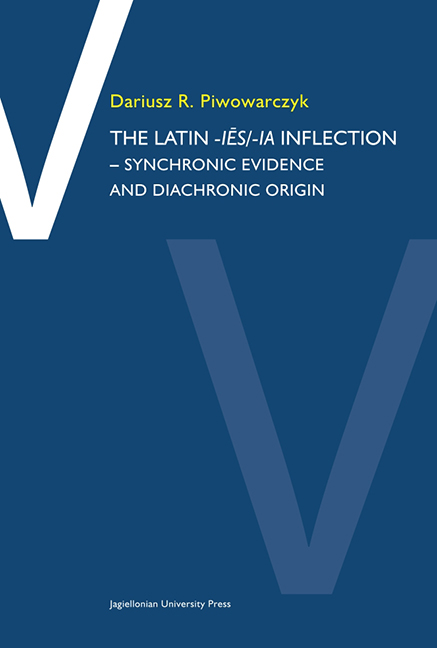Introduction
Published online by Cambridge University Press: 16 July 2022
Summary
The purpose of the following monograph is to investigate in detail the origin of the Latin nouns of the fifth declension in -iēs and the alternating -iēs/-ia type along with the -itiēs and -itiēs/-itia type. It has been observed long ago that Latin possessed stems in -ēs (rēs ‘thing,’ fidēs ‘faith’) and -iēs (diēs ‘ day,’ aciēs ‘ sharp edge’) which had the typical paradigm characteristic of the fifth declension (that is, the -ē-stems) along with the stems in -iēs and -itiēs which alternated with -ia and -itia of the first declension (cf. māteriēs, effigiēs, notitiēs alongside māteria, effigia, notitia). I will term these three types the rēs-type, aciēs-type (showing uniform -iēs throughout the paradigm) and the māteriēs type (showing the alternation between -iēs and -ia forms in the paradigm) for the sake of convenience. There have been numerous attempts at explaining the precise origin of this formations but none has succeeded so far in explaining all the facts without problems. In this work I will present the synchronic Latin material and the diachronic evidence for every form and I will put forward a solution which, in my opinion, would be the best to explain the origin of those formations.
The outline of the work is as follows: in the first chapter an outline of the Indo-European derivational morphology is presented taking into account the contemporary theory of classifying the proto-language inflectional classes not into stems but according to their affiliation within the particular accentablaut paradigm. Afterwards, the basic theoriēs on the word-formation are presented: external (additive and substitutive) and internal derivation and the problem of productivity. In the second chapter the Latin fifth declension is presented with the discussion of its most representative forms and the views on its origin. In the third chapter all of the Latin -iēs, -iēs/-ia and -itiēs/-itia formations are presented. The earliēst attestations are given for every form with the illustrations taken from the representative texts, alongside with the possible derivational base, if attested in Latin, and the etymology which includes the comparative evidence from the other Indo-European languages.
- Type
- Chapter
- Information
- The Latin -iés/ia Inflection , pp. 9 - 10Publisher: Jagiellonian University PressPrint publication year: 2022



